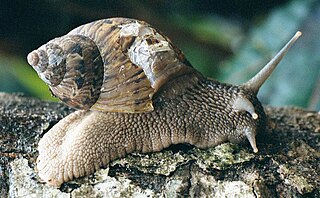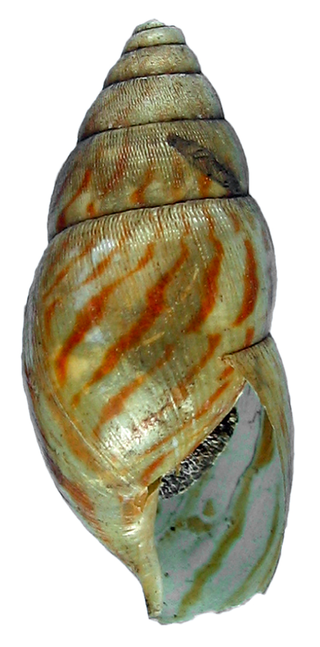
Pulmonata or pulmonates is an informal group of snails and slugs characterized by the ability to breathe air, by virtue of having a pallial lung instead of a gill, or gills. The group includes many land and freshwater families, and several marine families.

Stylommatophora is an order of air-breathing land snails and slugs, terrestrial pulmonate gastropod molluscs. This taxon includes most land snails and slugs. Stylommatophorans lack an operculum, but some close their shell apertures with temporary "operculum" (epiphragm) made of calcified mucus. They have two pairs of retractile tentacles, the upper pair of which bears eyes on the tentacle tips. All stylommatophorans are hermaphrodites.
Aaadonta angaurana is a small air-breathing land snail, a terrestrial pulmonate gastropod mollusc in the family Endodontidae.

Aaadonta is a genus of air-breathing land snails, terrestrial pulmonate gastropod mollusks in the family Endodontidae. Specimens from this genus are endemic to Palau.

Aaadonta constricta is a species of land snail, a terrestrial pulmonate gastropod mollusk in the family Endodontidae. It is endemic to Palau, where it is known from the islands of Babeldaob, Ngemelis, Peleliu and Koror. It may be extirpated from Koror. It is threatened by habitat destruction and modification.

Aaadonta fuscozonata is a species of air-breathing land snail, a terrestrial pulmonate gastropod mollusc in the family Endodontidae. This species is endemic to Palau, where it is known from Koror and Peleliu, and the small islands of Ngemelis and the northern Rock Islands. This snail inhabits tropical moist lowland forest, and is threatened by the destruction and modification of its habitat.
Aaadonta irregularis is a species of snail, a terrestrial pulmonate gastropod mollusk in the family Endodontidae. It is endemic to Palau, where it was only known from Peleliu, but has only been found recently on the very small island of Omekang. It is threatened by the destruction and modification of its tropical moist lowland forest habitat.
Aaadonta kinlochi is a species of snail, a terrestrial pulmonate gastropod mollusk in the family Endodontidae. It is endemic to Palau, where it was known from Angaur and Ulong Island. If it is still extant, it is threatened by the destruction and modification of its tropical moist lowland forest habitat.
Aaadonta pelewana is a species of snail, a terrestrial pulmonate gastropod mollusk in the family Endodontidae. It is found in Palau, where it was known from Peleliu and Koror. If it is still extant, it is threatened by the destruction and modification of its tropical moist lowland forest habitat.
Opanara is a genus of small air-breathing land snails, terrestrial pulmonate gastropod mollusks in the family Endodontidae.

Sinployea is a genus of small air-breathing land snails, terrestrial pulmonate gastropod mollusks in the family Charopidae.

Orthalicidae are a family of tropical air-breathing land snails, terrestrial pulmonate gastropod mollusks are classified in the subfamily Orthalicoidea of the order Stylommatophora.

Subulininae is a subfamily of small tropical air-breathing land snails, terrestrial pulmonate gastropod mollusks in the family Achatinidae.

Cerionidae is a family of air-breathing land snails, terrestrial pulmonate gastropod mollusks in the superfamily Urocoptoidea.

Sigmurethra is a taxonomic category of air-breathing land snails and slugs, terrestrial pulmonate gastropod molluscs. This is an informal group which includes most land snails and slugs.

The Clausilioidea are a superfamily of air-breathing land snails and slugs, terrestrial gastropod mollusks in the informal group Sigmurethra.
George Alan Solem, known professionally as Alan Solem, was an American malacologist, a biologist who studied mollusks.

Achatina vassei is a species of air-breathing land snail, a terrestrial pulmonate gastropod mollusk in the family Achatinidae, the giant African snails.
Ba humbugi is the only species and therefore the type species in the genus Ba, a genus of land snail, belonging to the family Charopidae. Both the genus and the species were named by the American malacologist Alan Solem. The genus is endemic to the Fijian island of Viti Levu, and B. humbugi is an endangered species.

Kleokyphus is a genus of small air-breathing land snails, terrestrial pulmonate gastropod mollusks in the family Endodontidae, an endemic family of land snails from the Hawaiian islands.












